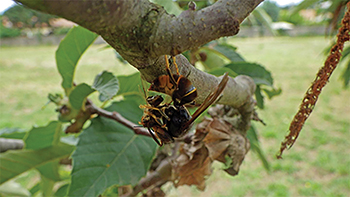
Asian hornets attack honey bee colonies in much of Europe. The United Kingdom doesn’t want this hungry predator feasting on their hives. They’ve set up an effective eradication program, successfully destroying the unwanted invaders on two separate incursions.
New technology will make finding the nests of these voracious hornets easier. Research shows that electronic radio tags can be used to track invasive Asian hornets and stop them colonizing the UK and killing honey bees.
Scientists from the University of Exeter attached tiny tags to Asian hornets, then used a tracking device to follow them to their nests; the first time this has been achieved. They tested the technique in southern France and Jersey – where Asian hornets are well established – and the tags led researchers to five previously undiscovered nests.
“Our new method of tracking offers a really important new tool to tackle the spread of this invader, providing an efficient means of finding hornets’ nests in urban, rural and wooded environments,” said lead researcher Dr. Peter Kennedy, of the Environment and Sustainability Institute on the University of Exeter’s Penryn Campus in Cornwall. The technique demonstrated in their study could help protect Britain’s “beleaguered pollinator populations”.
“It is vital to find the nests early in the season to prevent the hornet spreading, as later in the year hundreds of new queens emerge and disperse from each nest, each with the potential to make new nests,” said Professor Juliet Osborne, a co-author on the study. The work was funded as part of Defra’s efforts to prepare for future outbreaks of the Asian hornet in the UK.
Nicola Spence, Defra Deputy Director for Plant and Bee Health, said: “This work is key for ensuring a rapid response to Asian hornets when sightings are confirmed, and in future bee inspectors will be able to use this technique to take swift action.”
“In France, the Asian hornet is unlikely to be eliminated, so efforts are now focused more on limiting their impact,” said Dr. Denis Thiéry from INRA Bordeaux-Aquitaine in France, who collaborated on this work.
Mr Willie Peggie, Director of The States of Jersey Department of the Environment, where the technique was also tested, said: “We are pleased to be investigating efficient methods of tracking Asian hornets to their nests, as we’re concerned about their impact on our wild insect pollinators, as well as their effect on local honey production.”
The researchers used the smallest radio tags available – made by UK firm Biotrack Ltd – and attached them to hornets with sewing thread. Hornets were able to carry them as long as the tag weighed less than 80% of the insect’s weight.
The British Beekeepers Association are also pleased about the development of a reliable technique for tracking this invasive predator, and stated: “The BBKA are greatly concerned about the possible incursion by the Asian Hornet because of the devastation likely to be caused to honey bees and other pollination insects.”
Adult Asian hornets “hawk” at beehives, meaning that they hover outside to grab bees, before dismembering them and taking them back to their nest to feed to larvae.
The first Asian hornet discovered in Britain was in Gloucestershire in 2016, when a nest was found and destroyed. Another nest was destroyed in Woolacombe, Devon, last year. In April this year, a single hornet was found in Lancashire.
Asian hornets are smaller than native European hornets, have a largely dark brown or black body and yellow-tipped legs, a distinctive orange-yellow stripe near the end of their abdomen, and often a thin orange-yellow line just behind the “waist.” Their face is orange, and the back of the head is black, unlike the European hornet in which both the face and back of the head are yellow.
Any suspected sighting of an Asian hornet should be reported, ideally with a photo, via email to alertnon
native@ceh.ac.uk or by using the Asian Hornet Watch app.
The paper, published in the journal Communications Biology, is entitled: “Searching for nests of the invasive Asian hornet (Vespa velutina) using radio-telemetry.” http://dx.doi.org/10.1038/s42003-018-0092-9


